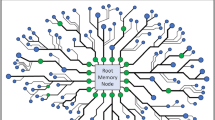Abstract
A DNA-based memory was implemented with in vitro learning and associative recall.The learning protocol stored the sequences to which it was exposed, and memories were recalled by sequence content through DNA-to-DNA template annealing reactions. Experiments demonstrated that biological DNA could be learned, that sequences similar to the training DNA were recalled correctly, and that unlike sequences were differentiated. Theoretically, the memory has a pattern separation capability that is very large, and can learn long DNA sequences. The learning and recall protocols are massively parallel, as well as simple, inexpensive, and quick. The memory has several potential applications in detection and classification of biological sequences, as well as a massive storage capacity for non-biological data.
Similar content being viewed by others
References
LM Adleman (1994) ArticleTitleMolecular computation of solutions to combinatorial problems Science 266 1021–1024 Occurrence Handle7973651
E Baum (1995) ArticleTitleBuilding an associative memory vastly larger than the brain Science 268 583–585 Occurrence Handle7725109
RS Braich N Chelyapov C Johnson PWK Rothemund L Adleman (2002) ArticleTitleSolution of a 20-variable 3-sat problem on a DNA computer Science 296 499–502 Occurrence Handle10.1126/science.1069528 Occurrence Handle11896237
Brennenman A and Condon AE (2001). Strand design for bio-molecular computation. http://www.cs.ubc.ca/ condon/papers/wordsurvey.ps
Brenner S, Williams SR, Vermaas EH, Storck T, Moon K, McCollum C, Mao J, Luo S, Kirchner JJ, Eletr S, DuBridge RB, Burcham T and Albrecht G (2000). In:Vitro cloning of complex mixtures of DNA on microbeads: Physical separation of differentially expressed cDNAs. Proceedings National Academy Science 97: 1665–1670
TM Cover (1965) ArticleTitleGeometrical and statistical properties of systems of linear inequalities with applications in pattern recognition IEEE Transactions on Electronic Computers 14 326–334
R Deaton J Chen H Bi JA Rose (2003) A software tool for generating non-crosshybridizing libraries of DNA oligonucleotides M. Hagiya A. Ohuchi (Eds) DNA Computing: 8th International Workshop on DNA-Based Computers, Berlin. University of Tokyo, Hokkaido University Sapporo, Japan
Deaton R, Murphy RC, Garzon M, Franceschetti DR and Stevens Jr. SE (1996). Good encodings for DNA-based solutions to combinatorial problems. In: Landweber LF., Baum EB. (ed). Proceedings of the Second Annual Meeting on DNA Based Computers. Volume 44., Providence, RI, DIMACS, American Mathematical Society (1998). 247–259 DIMACS Workshop, Princeton, NJ, 10–12 june
M Hagiya M Arita D Kiga K Sakamoto S Yokoyama (1997) Towards parallel evaluation and learning of Boolean μ-formulas with molecules 57–72 DIMACS Workshop Philadelphia, PA
J Hartmanis (1995) ArticleTitleOn the weight of computations Bulletin of the European Association for Theoretical Computer Science 55 136–138
S Haykin (1994) Neural Networks: A Comprehensive Foundation MacMillan College Publishing Co. New York
T Jiang M Li (1996) ArticleTitleDNA sequencing and learning Mathematical Systems and Theory 26 387–405
L Landweber RJ Lipton (1997) DNA2DNA computations: A potential “Killer App” [26] 59–68 DIMACS Workshop Philadelphia, PA
RJ Lipton (1995) ArticleTitleDNA solution of hard computational problems Science 268 542–545 Occurrence Handle7725098
A Marathe AE Condon RM Corn (1999) On combinatorial DNA word design. 75–90 DIMACS Workshop Massachusetts Institute of Technology Cambridge, MA
AP Mills B Yurke PM Platzman (1999) DNA analog vector algebra and physical constraints on large-scale DNA-based neural network computation. pp. 65–74 DIMACS Workshop Massachusetts Institute of Technology Cambridge, MA
D Normile (2002) ArticleTitleDNA-based computer takes aim at genes Science 295 951 Occurrence Handle10.1126/science.295.5557.951 Occurrence Handle11834795
JH Reif (2002) ArticleTitleSuccesses and challenges Science 296 478–479 Occurrence Handle10.1126/science.1070978 Occurrence Handle11964464
Reif JH, LaBean, TH, Pirrung M, Rana VS, Guo B, Kingsford C and Wickham GS (2002). Experimental construction of very large scale DNA databases with associative search capability. In:Jonoska N and Seeman NC (eds). DNA Computing: 7th International Meeting on DNA-Based Computers, Berlin, University of South Florida, Tampa FL, June 2001, Springer-Verlag 231–247 Lecture Notes in Computer Science 2340
Rubin H and Wood DH (eds). (1997). DNA Based Computers III, Providence, RI, DIMACS, American Mathematical Society (1999). DIMACS Workshop, Philadelphia, PA, 23–27 June
Sakakibara Y (2001). Solving computational learning problems with boolean formulae on DNA computers. In:Condon A and Rozenberg G (eds). DNA Computing: 6th International Meeting on DNA-Based Computers, Berlin, Leiden University, Leiden, NE, June 2000, Springer-Verlag 220–230 Lecture Notes in Computer Science 2052
J SantaLucia SuffixJr. (1998) ArticleTitleA unified view of polymer, dumbbell, and oligonucleotide DNA nearest-neighbor thermodynamics Proceedings National Academy Science 95 1460–1465 Occurrence Handle10.1073/pnas.95.4.1460
LG Valiant (1984) ArticleTitleA theory of the learnable Communications of the ACM 27 1134–1142 Occurrence Handle10.1145/1968.1972
Winfree E and Gifford DK (eds). (1999). DNA Based Computers V, Providence, RI, DIMACS, American Mathematical Society, (1999). DIMACS Workshop, Massachusetts Institute of Technology, Cambridge, MA, 14–16 June
E Winfree F Liu LA Wenzler NC Seeman (1998) ArticleTitleDesign and self-assembly of two-dimensional DNA crystals Nature 394 539–544 Occurrence Handle10.1038/28998 Occurrence Handle9707114
Methods for sorting polynucleotides using oligonucleotide tags. US Patent 5604097 (1997)
Author information
Authors and Affiliations
Corresponding author
Rights and permissions
About this article
Cite this article
Chen, J., Deaton, R. & Wang, YZ. A DNA-based memory with in vitro learning and associative recall. Nat Comput 4, 83–101 (2005). https://doi.org/10.1007/s11047-004-4002-3
Issue Date:
DOI: https://doi.org/10.1007/s11047-004-4002-3




